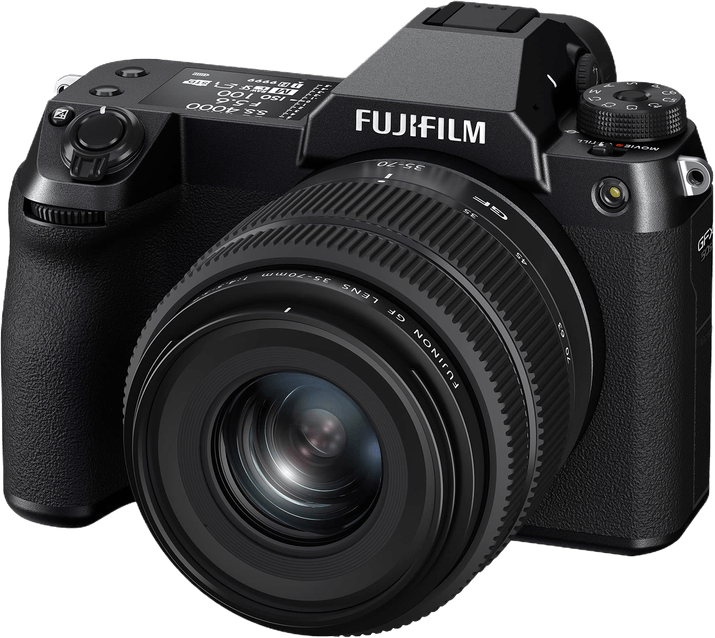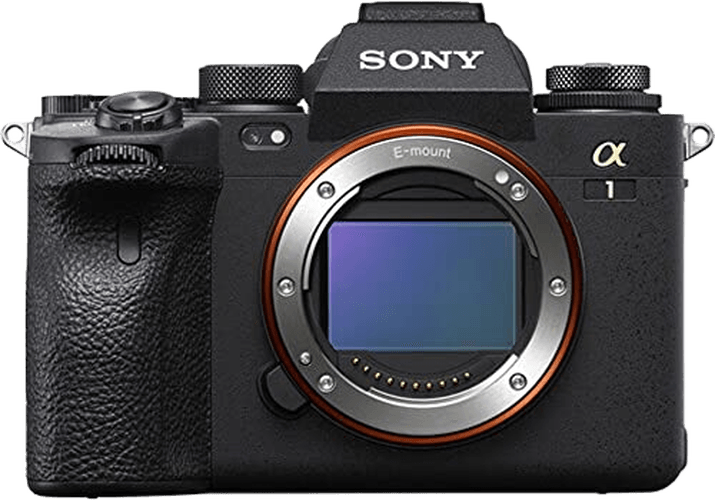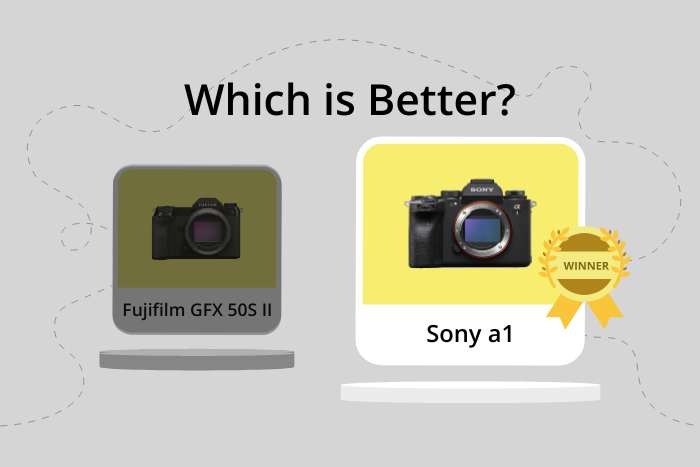Fujifilm GFX 50S II vs Sony a1 Comparison
Fujifilm GFX 50S II

Sony a1

The Sony a1 outperforms the Fujifilm GFX 50S II with a score of 86/100 compared to 79/100. Both cameras are mirrorless and were released in 2021. They share similarities in their design, but the Sony a1 is lighter at 737g and smaller at 129 x 97 x 81mm, making it more portable. Additionally, the Sony a1’s higher score reflects its superior performance and features.
On the other hand, the Fujifilm GFX 50S II has a lower launch price of $3999, making it more affordable than the Sony a1 at $6499. While the Sony a1 is the clear winner in terms of performance, the Fujifilm GFX 50S II offers a more budget-friendly option for those seeking a mirrorless camera.
Fujifilm GFX 50S II vs Sony a1 Overview and Optics
The Sony a1 takes the lead in optics with a score of 89/100, outperforming the Fujifilm GFX 50S II, which has a score of 77/100. Both cameras share some common specifications, such as a CMOS sensor, image stabilization, and a shooting speed of 3 for the Fujifilm GFX 50S II and 30 for the Sony a1. However, there are key differences that set these cameras apart in terms of optics.
The Sony a1 has a slight advantage in terms of megapixels, with 50.1 compared to the Fujifilm GFX 50S II’s 51. The Sony a1 also boasts a superior processor, the Dual Bionz XR, which contributes to its higher score. Additionally, the Sony a1 has a DXOMARK sensor score of 98, while the Fujifilm GFX 50S II does not have a DXOMARK score, as DXOMARK does not score Fujifilm cameras. This gives the Sony a1 a clear edge in image quality.
On the other hand, the Fujifilm GFX 50S II has a medium format sensor, which is larger than the full-frame sensor found in the Sony a1. This can result in better image quality and dynamic range in certain situations. The Fujifilm GFX 50S II also has a 4:3 aspect ratio, which may be preferable for some photographers compared to the Sony a1’s 3:2 aspect ratio.
Despite the advantages of the Fujifilm GFX 50S II’s medium format sensor and aspect ratio, the Sony a1’s higher score, faster shooting speed, and better processor make it a superior choice in terms of optics. The Fujifilm GFX 50S II is still a strong contender, but the Sony a1 stands out as the better option for those prioritizing image quality and performance.
Fujifilm GFX 50S II vs Sony a1 Video Performance
The Sony a1 outperforms the Fujifilm GFX 50S II in video capabilities, scoring 86/100 compared to the GFX 50S II’s score of 57/100. Both cameras share some common video features, but the Sony a1 has superior specifications in certain areas.
Both the Fujifilm GFX 50S II and the Sony a1 offer time-lapse functionality, which is a desirable feature for many videographers. However, the Sony a1 surpasses the GFX 50S II in terms of video resolution and frame rate. The a1 boasts an impressive 8K maximum video resolution with dimensions of 7680 x 4320, while the GFX 50S II only offers Full HD resolution with dimensions of 1920 x 1080. Additionally, the Sony a1 can record at a maximum video frame rate of 120fps, resulting in smoother, more realistic footage than the GFX 50S II’s maximum of 30fps.
The Fujifilm GFX 50S II does have a slight advantage over the Sony a1 in terms of built-in time-lapse functionality. While both cameras offer this feature, the GFX 50S II has it built-in, whereas the Sony a1 does not. This may be a small consolation for the GFX 50S II but does not make up for the significant differences in video resolution and frame rate.
Considering the significant differences in video capabilities, the Sony a1 is the clear winner in this comparison. Its superior video resolution and frame rate make it a better choice for videographers seeking high-quality footage. The Fujifilm GFX 50S II’s built-in time-lapse functionality is a nice feature, but it is not enough to compete with the Sony a1’s overall video performance.
Fujifilm GFX 50S II vs Sony a1 Features and Benefits
The Fujifilm GFX 50S II outperforms the Sony a1 in features, scoring 87/100 compared to the Sony a1’s 83/100. Both cameras share several specifications, including a touchscreen, flip screen, WiFi, and Bluetooth connectivity. However, neither camera has GPS.
The Fujifilm GFX 50S II excels in screen size and resolution. It has a 3.2-inch screen, larger than the Sony a1’s 3-inch screen. Additionally, the Fujifilm GFX 50S II offers a higher screen resolution of 2,360,000 dots, compared to the Sony a1’s 1,440,000 dots. This difference results in a clearer and more detailed display on the Fujifilm GFX 50S II, which can improve the user experience when reviewing photos or navigating the camera’s menu.
The Sony a1 has a few advantages over the Fujifilm GFX 50S II, despite its lower feature score. However, these advantages are not related to the features mentioned above. In this comparison, the Fujifilm GFX 50S II is the clear winner in terms of features due to its larger screen size and higher resolution.
Considering both cameras’ feature scores and specifications, the Fujifilm GFX 50S II is a better choice for photographers who prioritize screen size and resolution. The Sony a1 may still be suitable for those who value other aspects of camera performance, but it falls short in the features discussed. Ultimately, the Fujifilm GFX 50S II’s higher score reflects its superior performance in these specific features.
Fujifilm GFX 50S II vs Sony a1 Storage and Battery
The Sony a1 wins the storage and battery comparison with a score of 73/100, while the Fujifilm GFX 50S II scores 71/100. Both cameras have two memory card slots and support USB charging. They also accept UHS-II compatible memory cards. However, the Sony a1’s storage options are more versatile, as it accepts both SD and CFexpress Type A cards.
The Sony a1’s battery life is longer, providing 530 shots per charge compared to the Fujifilm GFX 50S II’s 440 shots. The a1 uses the NP-FZ100 battery, while the GFX 50S II uses the NP-W235 battery.
The Fujifilm GFX 50S II does not have any significant advantages in storage and battery over the Sony a1. The slight difference in scores reflects the a1’s better battery life and broader memory card compatibility.
Considering these factors, the Sony a1 is the better choice for those prioritizing longer battery life and more storage options. The Fujifilm GFX 50S II remains a solid option, but its storage and battery capabilities are slightly inferior to the Sony a1.
Fujifilm GFX 50S II vs Sony a1 Alternatives
Still not ready to make a decision? Our article comparing Fujifilm vs Canon or Fujifilm vs Olympus cameras may be helpful! Or, why not check out our other popular camera comparisons for inspiration:

